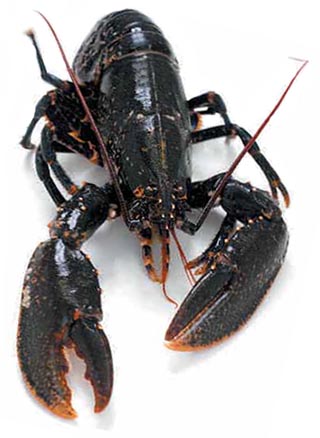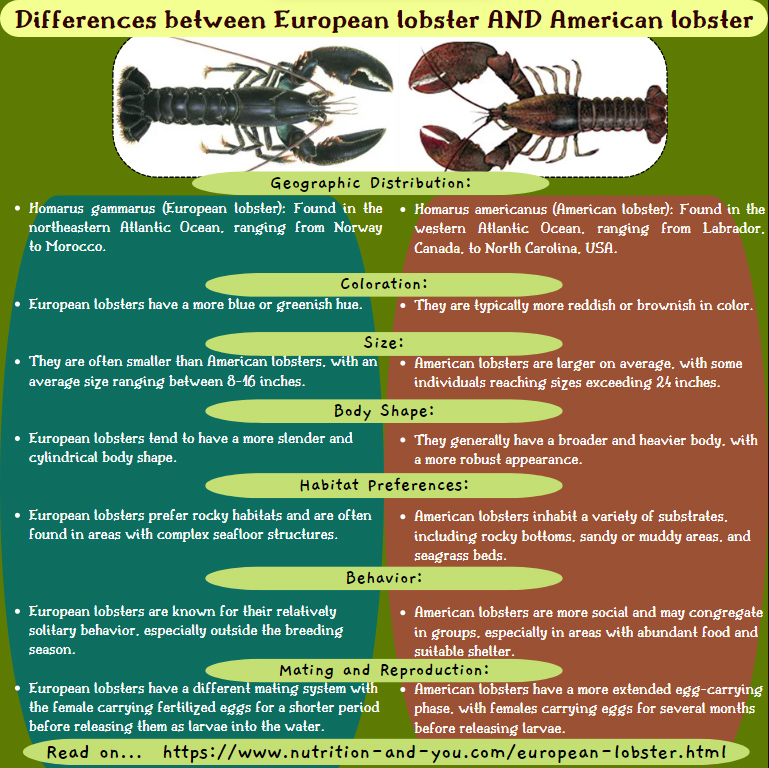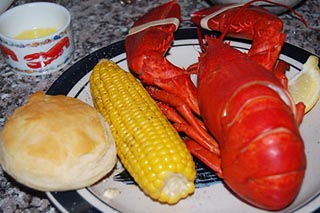Lobster Nutrition facts
Lobsters are large, deep-water crustaceans with elongated, robust bodies. Their uniquely firm, strongly flavored and tasty meat is highly valued by chefs worldwide.
Scientific name: Homarus americanus (American lobster), and Homarus Vulgaris (European lobster).
 |
| Giant American lobster (H. americanus. |
Habitat
Lobster lives in the cold, deep water of the Atlantic, preferably inhabiting ocean floors. It is essentially a nocturnal prey as it explores the ocean bottom in quest of food after sundown. In shallow waters, lobsters dwell in burrows during the day, however moving about at night, similar to other large crustaceans like crayfish and crabs.
Lobster scavenges on fish, alive or dead, almost all kinds of invertebrate animals that inhabit the ocean bottom, and small quantities of algae and sea vegetables.
Description:
Lobsters are one of the largest crustaceans, several-fold bigger than crayfish, and shrimps. They feature a heavily spined, cylindrical body with a long tail. They differ from crayfish (spiny lobsters) by having large, well-developed claws on the first pair of legs (as in crabs). The abdomen is smoother, having six somites.
They come in many colors depending on different subspecies, ranging from olive green to red.
The European blue lobster (Homarus gammarus) is much sought-after crustacean found in the cold waters of the Eastern North Atlantic, from Norway down to Morocco. The American lobster or Maine lobster (H. americanus) is the larger species found on the eastern coast of North America, from the coast of Maine to Florida.
See the differences between European lobster (Homarus gammarus) and American lobster (H. americanus) in an infographic:
 |
Health Benefits of Lobsters
Lobster, being a crustacean, is low in calories. 100g of its tail meat holds just 112 calories. Its white meat is low in fat; just 1.51g per 3 oz (100 g).
Their lean, non-oily white meat is an impressive source of protein. 100 g of lobster meat holds 20.6 g/100g (37% of RDI) of protein that is complete in all essential amino acids in healthy proportions.
Research studies suggest that eating seafood can decrease the risk of heart attack, stroke, obesity, and hypertension. Seafood is low in saturated fat and high in “heart healthful” polyunsaturated fat, including omega-3 fatty acids.
American Heart Association recommends consumption of seafood, including crustaceans, to fulfill requirements of essential fatty acids, protein, minerals, and fat-soluble vitamins.
Unlike some oily fish like mackerel, lobster meat contains very small amounts of vitamin-A, but moderate concentrations of long-chain omega-3 fatty acids (PUFA).
It composes just 17 IU/100g of vitamin A and a total- 0.407 g of omega-3 fatty acids. Vitamin A and omega-3 are essential for healthy mucosa and skin.
Lobster essentially preys on small fish mollusk, insects, and zooplankton which are the finest sources of B-complex vitamins. Lobster meat is a good source of folates, niacin, vitamin B6, thiamin, and riboflavin.
Invertebrates, like Lobster, are at the bottom of the food chain and concentrate very small amounts of heavy metals like mercury. The Food and Drug Administration (FDA) recommends that pregnant women eat at least 8 ounces and up to 12 ounces (340 grams) of a variety of seafood lower in mercury a week.
Lobsters are a very rich source of minerals including phosphorus (34% RDI), iron (15% RDI), zinc (51.5% RDI), selenium, iodine, calcium, potassium, and magnesium.
| Principle | Nutrient Value | Percent of RDA |
|---|---|---|
| Energy | 112 Kcal | 5.6% |
| Carbohydrates | 2.43 g | 2% |
| Protein | 20.6 g | 37% |
| Total Fat | 1.51 g | 7.5% |
| Cholesterol | 0 mg | 0% |
| Dietary Fiber | 0 g | 0% |
| Vitamins | ||
| Folates | 0 μg | 0% |
| Niacin | 4.245 mg | 26.5% |
| Pyridoxine | 0.15 mg | 1% |
| Riboflavin | 0.046 mg | 3.5% |
| Thiamin | 0.007 mg | <1% |
| Vitamin-A | 17 IU | 0.5% |
| Vitamin-C | 2 mg | 4% | Electrolytes |
| Sodium | 177 mg | 12% |
| Potassium | 180 mg | 4% |
| Minerals | ||
| Calcium | 49 mg | 5% |
| Iron | 1.22 mg | 15% |
| Magnesium | 40 mg | 10% |
| Phosphorus | 238 mg | 34% |
| Zinc | 5.67 mg | 51.5% |
| Omega-3 fats | ||
| EPA (20:5 n-3) | 0.265 g | -- |
| DPA (22:5 n-3) | 0.034 g | -- |
| DHA (22:6 n-3) | 0.108 g | -- |
Buying
Fresh Lobsters are available year-round on the Eastern coast of the US. Always choose a live lobster in the markets. It can live 3-5 days away from its natural habitat if placed in a cold, saltwater fish tank. When grasped by the sides, it should curl its tail abruptly beneath its body. It should have black, shiny eyes, firm meat, and a pleasant smell.
At home, lobsters must be kept in cold seawater below 40 F. However, they may be kept covered in damp, cool cloth while out of the water for a short duration.
Preparation
Lobsters are one of the most sought-after seafood for their lean, firm, and delicious white/pink-tinged meat. The edible parts are the meat of the tail, the legs, the claws, and sometimes the liver. The white and pink-tinged meat of lobster is lean, firm, delicate, and very tasty.
Chefs prefer to cook frozen, numb lobsters instead of living ones. The meat tends to become tough and chewy because of the stiffening of muscles (rigor mortis) if cooked alive. Live lobster is placed in a deep freezer for 1 hour, which renders them unconscious.
They can be boiled, baked, girdled, grilled, etc. Use a 500-600g whole lobster per person. The yield is approximately 40%.
For grilling, cut the lobster lengthwise; brush the claws with oil, and season with lemon juice, and ground pepper.
Once cooked, lobsters turn into maroon, irrespective of their original color.
Here are some serving ideas:
 |
| Maine lobster dinner. Photo credit: Renée Johnson. |
At lobster restaurants, a set of lobster crackers and a long, thin tool for pulling meat from inaccessible areas are suggested as basics. Eating a lobster can get messy, and most restaurants offer a lobster bib.
lobster meat and corn chowder is a relishing appetizer.
Serve Boston-style boiled lobster with a corncob, boiled potatoes, and sauce.
Baked or boiled; it is greatly enjoyed with garlic or lemon butter, with mayonnaise or plain.
It is eaten cooked, hot, or cold in salads and sandwiches.
Lobster is prepared as a bisque, soufflée or in mousse and can be grateened.
Lobster thermidor (a French dish consisting of a creamy mixture of cooked lobster meat, egg yolks, stuffed into a lobster shell), lobster a l'americaine and lobster newwburg are classic lobster dishes.
The shell can be used to make fish stock and to flavor bisques, stews, and sauces.
Safety profile
Allergy to crustaceans may appear in 1% of the population and is more common in teenage and adult life than very early childhood.
Many allergic reactions to seafood are mild and cause hives (urticaria), tingling of the throat and mouth, swelling (angioedema), and/or gut reactions (vomiting, diarrhea). (Medical disclaimer).
Also read ≻≻-
≻≻-European Blue Lobster nutrition facts and health benefits.
≻≻-Shrimp nutrition facts and health benefits.
≻≻-Crawfish nutrition facts and health benefits.
≻≻-Anchovies nutrition facts and health benefits.
≻≻-Back to Seafood from Crawfish nutrition facts and health benefits.
Further reading (Links opens in new window):
Omega-3 Fatty Acids: An Essential Contribution.